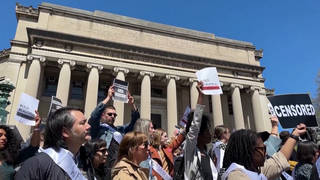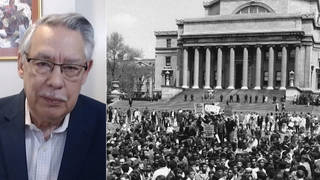
Related
Shocking new details have been made public about the CIA’s torture program as the agency has declassified dozens of once-secret documents. A portion of the new documents deal with a prisoner named Gul Rahman, who froze to death at a secret CIA prison in 2002. Rahman’s family is now suing CIA-contracted psychologists James Mitchell and John “Bruce” Jessen, who helped design the U.S. torture program. The new records also show a prisoner who was waterboarded 83 times was likely willing to cooperate with interrogators before the torture. The account from medical personnel who helped with the first waterboarding of Abu Zubaydah deals a major blow to the CIA’s insistence it gained crucial information through torture. Zubaydah said he made up fake terrorist plots in order to stop the abuse. Another partially declassified document reveals President Bush was uneasy about what the agency was doing. One 2006 memo read, “The president was concerned about the image of a detainee, chained to the ceiling, clothed in a diaper and forced to go to the bathroom on themselves.” We speak with Dror Ladin, an attorney with the American Civil Liberties Union who helped win the release of these documents.
Transcript
JUAN GONZÁLEZ: Shocking new details have been revealed in public about the CIA’s torture program as the agency has declassified dozens of once-secret documents. A portion of the new documents deal with a prisoner named Gul Rahman, who froze to death at a secret CIA prison in 2002. Rahman’s family is now suing CIA-contracted psychologists James Mitchell and John “Bruce” Jessen, who helped design the U.S. torture program.
The new records also show a prisoner who was waterboarded 83 times was likely willing to cooperate with interrogators before the torture. The account from medical personnel who helped with the first waterboarding of Abu Zubaydah deals a major blow to the CIA’s insistence it gained crucial information through torture. Zubaydah said he made up fake terrorist plots in order to stop the abuse.
AMY GOODMAN: Another partially declassified document reveals President Bush was uneasy about what the agency was doing. One 2006 memo read, quote, “The president was concerned about the image of a detainee, chained to the ceiling, clothed in a diaper and forced to go to the bathroom on themselves.”
Joining us now is Dror Ladin, attorney with the ACLU, the American Civil Liberties Union, who helped win the release of these documents.
Dror, welcome to Democracy Now! What did you find?
DROR LADIN: I mean, we found so much more evidence of what everyone already knows, which is that the CIA torture program was not at all some scientific method of getting information from bad people who would only give it up under torture. But instead it was an exercise in brutality against people who the CIA didn’t know whether they had information, whether they didn’t have information, and where the only answer was more torture whenever they didn’t get the answers they wanted. The result, we learn, is not only the brutality against individuals, but also actual damage to the country’s ability to gather intelligence. So, these documents are the CIA’s own account of their failures.
JUAN GONZÁLEZ: And the role of psychologists in this? What do the documents show?
DROR LADIN: I mean, the role of psychologists is horrifying. So we represent also in another lawsuit Gul Rahman’s family over his death under torture. And these documents now reveal why he was singled out for such brutality. And it’s because of this psychological theory that they could identify someone who was a sophisticated resister, and then deploy this escalating set of tortures in order to break him. And when you now have these reports, we can see why they thought he was such a sophisticated resister. And this is what it is: He complained about the violations of his human rights. He complained about the poor treatment. And in a detention facility in which he would freeze to death from hypothermia, he said he had trouble thinking because it was so cold. They write this down in cables and say, “Gul Rahman is a very sophisticated resister. We need to employ even more brutality.”
A different part of the documents describes how senior people at the agency believed that waterboarding was, quote, “a silver bullet,” and they would rapidly escalate to it. So the whole torture program, when it finally became public, was sold by the CIA as if it was very carefully calibrated, they would only do what they needed to get people to cooperate. But the reality was nothing like that. They would just immediately go to the worst possible thing they could do. And people like Gul Rahman paid the price.
AMY GOODMAN: Talk about Abu Zubaydah, the waterboarding 83 times, and about the fact that they said he would talk before the torture.
DROR LADIN: Yeah, the remarkable thing is that a lot of people think that the CIA program, you know, they would only go to torture, again, when they knew that someone was holding information that’s a ticking time bomb, whatever. But the thing is, they don’t actually know that, going into it. And so, with Abu Zubaydah, they didn’t even know who he was. They were convinced he was the number three person in al-Qaeda. And in these new—some of the new transcripts we have are the testimony that he gave at Guantánamo, in which he says even the CIA tells him, “Oh, we made a big mistake with you.”
But that big mistake, you know—the way the CIA operated is that you had the people on the ground doing the torture, and then you had these analysts back at headquarters who would say, “Oh, he hasn’t told you about the plot? Well, he definitely knows about a plot, so you should torture him further.” And one of the remarkable things about the cables that we just uncovered is you see actually the torturers talking to headquarters and saying, “We don’t know. I mean, we’ve been torturing him for a while now, and it really doesn’t seem like there’s much left to say.” And they say, “Oh, we can’t believe that there’s nothing more. Torture further.”
JUAN GONZÁLEZ: And the information about the pangs of conscience of President Bush?
DROR LADIN: You know, it’s hard to credit that, but on the other hand, I think a lot of people think of torture in a more abstract way rather than thinking of a detainee chained to the ceiling in a diaper. And so, I think that, you know, the president or anyone else, when ultimately confronted with the brutality of it, has to really think again, you know, “Is this who we are? Is this—even imagining that it was, you know, effective”—which we know it wasn’t—”is this who we are?”
AMY GOODMAN: Do you now have evidence for lawsuits for crimes, charges of war crimes to be brought up against U.S. officials, right on up to the president, for what they knew and when they knew it?
DROR LADIN: I mean, that’s the thing that is horrifying about this, is that these are war crimes. This is evidence of war crimes. And yet no one’s been prosecuted. No senior official has ever been prosecuted. The ACLU can’t prosecute people. We have a damages lawsuit on behalf of the victims. But the Department of Justice, you know, needs to prosecute people. Human Rights Watch just called—you know, renewed its call for prosecutions based on these new documents. It’s something we’ve long said. But the government has to actually want to do it. And that’s a problem.
AMY GOODMAN: Very quickly, how did you get these documents? And are there more?
DROR LADIN: We got these documents through a Freedom of Information Act lawsuit. Some of them we’ve been fighting over for over a decade. And yes, there will be more. There’s so much more left to know about this program, and it’s essential that we know about it now.
AMY GOODMAN: Dror Ladin, we want to thank you for being with us, staff attorney at the ACLU National Security Project, counsel in the FOIA case that led to the release of the CIA documents, as well as in the ACLU suit against Mitchell and Jessen, the two psychologists who designed the CIA torture program.
That does it for our show. Democracy Now! has three job openings: office coordinator, news producer and a senior video news producer. Go to our website at democracynow.org and apply immediately.










Media Options